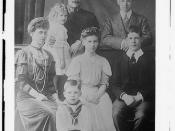A Romance of the Republic, written by Lydia Maria Child, is an intriguing novel which
reflects certain predominant 19th-century views about racism, patriarchy, and class status. One
aspect of this story that is unique is the constant use of a flower motif, through which the reader
is drawn into a Paradise that is fantastically created, an Eden that is not limited in its range of
vision due to the wealth, class, nationality, and color of its individuals, but rather embraces
the many hues and varieties of life that any beautiful and perfect garden must possess. Although
one could argue that this utopia is never obtainable, Ms. Child successfully demonstrates that a
society can be egalitarian, not constructed on class consciousness and struggle, but rather based
on the framework of the Constitution, which states that all people are created equal, with unity
for all being the ultimate goal. These beliefs in equality are demonstrated through the strategic
use of class where the aristocratic faction should not have more value than their lower class
counterpoints. They are also reflected in the novel's use of racial crossing, where many varieties
of people, including the pivotal octoroon sisters, Rosa and Flora, can have many potential colors
and racial identities. Finally, the egalitarian beliefs are evidenced in cultural differences, where a
society can only evolve into a more splendid creation when it derives sustenance from many
groups and resources.
The fact that this book deals with the aristocracy at all turns presents an excellent
summation on the beliefs that money and prestige are not always used just for the purpose of
keeping the lower classes down, but can be used for the good of all peoples if the wealthy are
willing to share their good fortune. The characters of Mr. King, Mr. Blumenthal, and...


